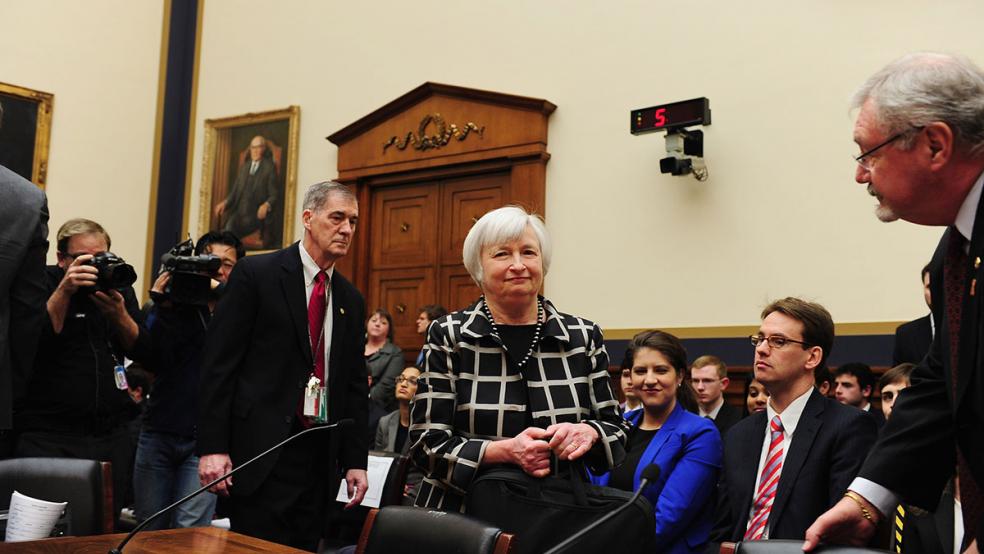New Federal Reserve Chair Janet Yellen on Tuesday made it clear she would not make any abrupt changes to U.S. monetary policy, saying the central bank was on track to keep reducing its stimulus even though the labor market recovery was "far from complete."
In her first public comments as chief, Yellen said the Fed would need to keep its eye on the number of long-term unemployed Americans and those working only part-time but who want a full-time job, as it begins to plot a tricky reversal of it very accommodative policy stance.
Related: Yellen’s High-Stake Challenge on Unemployment
Yellen, addressing lawmakers on the House Financial Services Committee, emphasized continuity in the Fed's policy strategy, saying she strongly supports the approach driven by her predecessor, Ben Bernanke.
Under Bernanke, the Fed bought trillions of dollars worth of bonds to drive long-term borrowing costs lower in the wake of the deep 2007-2009 recession. In December, in a nod to a drop in unemployment and stronger economic growth, it started to scale back its latest asset purchase program.
While the U.S. unemployment rate has fallen by 1.5 percentage points since the latest bond-buying program began in September of 2012, at 6.6 percent the rate remains "well above levels" the Fed sees as consistent with maximum sustainable employment, Yellen said.
"(T)he recovery in the labor market is far from complete," she said.
Related: The Hidden Reason for January’s Dismal Jobs Report
The Fed has trimmed asset purchases in each of the last two months; it now buys $65 billion in Treasuries and mortgage bonds per month in an effort to keep borrowing costs low across the economy and to encourage investment and hiring.
Yellen said the Fed will "likely reduce the pace of asset purchases in further measured steps at future meetings" if economic data broadly supports policymakers' expectation of improved labor markets and a rise in inflation.
She said, however, the purchases are not on a pre-set course, repeating the Fed's policy line. And she reinforced the central bank's expectation that inflation, while low now, will rise back toward the Fed's 2-percent goal.
Yellen, in only her second week on the job after serving as the Fed's vice chair, nodded to the recent volatility in global financial markets, but said at this stage it does "not pose a substantial risk to the U.S. economic outlook."
Related: Do Businesses Benefit from Unemployment?
Prices for U.S. government bonds slipped and the dollar rose against the euro as investors digested Yellen's comments. U.S. stocks opened the day higher.
"It's very obvious she is working from the same playbook as Bernanke," said Tom Porcelli, chief U.S. economist at RBC Capital Markets in New York. "The Fed will continue to cut its bond purchases by $10 billion at each policy meeting the rest of the year."
Eye on the Jobs Market
The House committee's chairman, Jeb Hensarling of Texas, is a long-standing critic of the aggressive Fed stimulus, which he argues has enabled a huge run-up in U.S. debt. In opening remarks, he asked whether the so-called quantitative easing program will become "QE infinity."
Republicans worry about the limited effectiveness, and even dangers, of a central bank balance sheet now worth $4 trillion and counting. Many worry the Fed's largesse could let inflation get out of hand or fuel asset bubbles.
But Yellen, long a proponent of asset purchases, cited the "unusually large fraction" of jobless Americans who have been out of work for more than six months, and the "very high" number of part-time workers who would prefer full-time jobs.
"These observations underscore the importance of considering more than the unemployment rate when evaluating the condition of the U.S. labor market," she said.
The Fed has said it does not expect to raise interest rates from near-zero until well after the time the jobless rate drops below 6.5 percent, especially if inflation remains weak. But with the jobless rate on the cusp of breaching this threshold, policymakers are considering how best to adjust their guidance.
More than five years after the 2007-2009 recession ended, the Fed has embarked on perhaps its most difficult policy shift as it tries to back away from flooding the financial system with ultra-easy money while at the same time convince investors that interest rates will stay near zero well into next year.
A shaky run of data has raised questions over whether the U.S. economy can sustain the strength it showed in the second half of last year. While the unemployment rate dropped more than a percentage point over the past year, jobs growth slowed sharply in the last two months.
The weak U.S. jobs growth and a recent selloff in emerging markets that also hit Wall Street could complicate things for the Fed.
Related: Millennials’ Joblessness Costs the Government $8.9 Billion a Year
Yellen said the Fed was watching the recent market volatility closely.
"Our sense is that at this stage these developments do not pose a substantial risk to the U.S. economic outlook," she added. "We will, of course, continue to monitor the situation."
Noting inflation remains below the Fed's 2 percent target, Yellen said "the recent softness reflects factors that seem likely to prove transitory, including falling prices for crude oil and declines in non-oil import prices." The Fed will not let inflation run "persistently above or below" its 2 percent goal, she added.
Long concerned with the pain the recession caused U.S. workers, Yellen is sometimes seen as more dovish than Bernanke and thus willing to do more to stimulate the economy even if inflation could eventually ramp up as a result.
Top Reads from The Fiscal Times:




